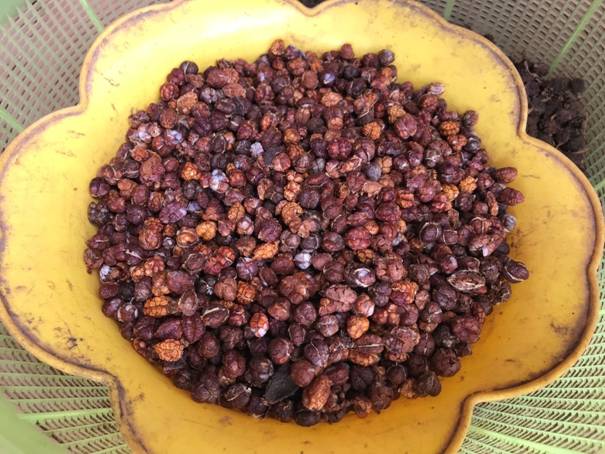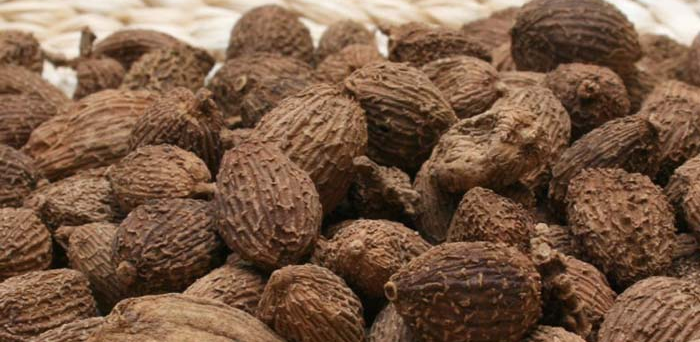Cardamom in Vietnamese cuisine
Cardamom is an umbrella term for several genuses under Zingiberaceae (ginger) family: Amomum, Elettaria, Wurfbainia, Lanxangia, Meistera or even Aframomum. Most of these genuses were previously classified in Amomum genus, however modern biologists re-classified into more genuses (like Wurfbainia, Lanxangia…).
In Vietnam, cardamoms are generally called sa nhân in Vietnamese and considered as an ingredient for herbal medicine. Most of them are harvested in the wild forests or in farms and then exported to China. Besides, cardamoms are used a spice in cooking, too, especially as a spice ingredient in five-spice condiment. Many Vietnamese cooks are unaware of cardamoms although they do use five-spice powder in cooking. The most popular cardamon used in cooking in Vietnam is tsaoko cardamom (thảo quả).
1. Tsaoko cardamom
(Lanxangia tsaoko, formerly Amomum tsaoko, Vietnamese: thảo quả)
Tsaoko cardamom grows wild in cool climates in mountainous northern Vietnam, espically in Lào Cai, Yên Bái, Hà Giang, and Lai Châu. In Lào Cai and Hà Giang, tsaoko plants are also cultivated commercially for spices. Tsaoko cardamom is known for its aromatic smell. Dried tsaoko cardamon pods are often pounded into powder to flavor some cakes and desserts like bánh chưng (a type pf glutinous rice cake) and chè kho (a type of mung bean cake). Tsaoko cardamons are also used in phở to enhance the flavor of the broth or in some beef braise dishes.. Tsaoko is also an ingredient in five-spice powder.


Tsaoko cardamon is often confused with Nepal black cardamom (Amomum subulatum). The latter is not native to Vietnam, and also unknown to the Vietnamese cooks in Vietnam. Also, the Indian green cardamoms are also planted in Vietnam, but Vietnamese chefs find green cardamoms less flavorful and they prefer the “true” tsaoko cardamoms.
2. PURPLE CARDAMOM
(Wurfbainia longiligularis, formerly Amomum longiligulare, Vietnamese: sa nhân tím)
In Vietnam, purple cardamom is widely cultivated in the Central Highlands provinces such as Đắc Lắc, Gia Lai, Bình Định, Phú Yên. It is also grown in smaller scale in some northern provinces. Purple cardamom is known for some medicinal uses. In Vietnam, purple cardamoms are also used to submerge in rice wine to make aromatic cardamon wine. Purple cardamoms and can also be used an ingredient to make five-spice condiment. They are planted mainly for exports to China, and Japan.


3. RED CARDAMOM
(Wurfbainia villosa, formerly Amomum villosum, Vietnamese: Sa nhân đỏ, Dương Xuân Sa)
Red-skinned cardamon is similar to the aforementioned purple cardamom, but it is less popular than the purple one.

4. SPINY CARDAMOM
(Amomum villosum var. xanthioides or Amomum xanthioides, Vietnamese: sa nhân gai, sa nhân ké, Súc Sa).
Also known as medicinal cardamom in Korea, spiny cardamom is closely related to red cardamon. Dried red cardamoms and spiny cardamoms are collectively called sa nhân trắng or simply sa nhân in Vietnamese. This is a wild cardamom species with small and prickly pods. Their pods which sometimes are harvested in the wild to make aromatic wine.

5. Other cardamoms
There are many other types of cardamon that grows in the wild or cultivated at a modest scale including: Green cardamom (Elettaria cardamomum, formerly Amomum cardamomum, Vietnamese: thảo quả xanh, tiểu đậu khấu, bạch đậu khấu), koenig cardamom (Meistera koenigii or Amomum koenigii, Vietnamese: thảo quả đồng), tomrey cardamom (Meistera tomrey, formerly Amomum tomrey, Vietnamese: Mè tré bà)…


